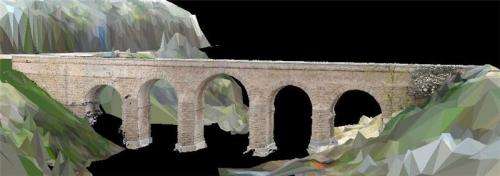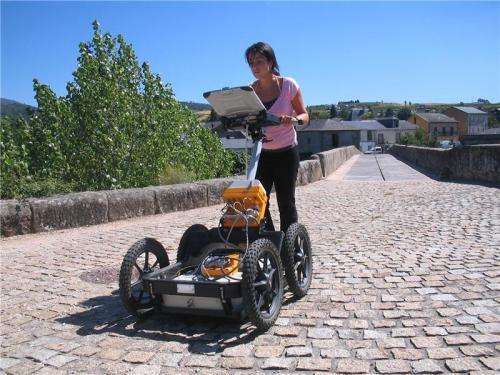Laser and radar unveil the secrets of Roman bridges

Discovering hidden arches, visualising the sloped outline characteristic of the medieval period, finding a Renaissance engraving on a roman arch or detecting restorations: these are some of the results that have been obtained by researchers at the University of Vigo (Spain) in their study of more than 80 roman and medieval bridges. The assessment was carried out with the help of a ground-penetrating radar, a laser scanner and mathematical models, technology that benefit conservation.
In recent years, UNESCO and other organisations concerned with the conservation of cultural heritage have underlined the importance of using non-destructive methods to document monuments´ characteristics and evaluate their state of conservation.
Along these lines, researchers from the Applied Geotechnology Group at the University of Vigo have used laser and radar to study, using light beams and waves, around 85 ancient bridges in north-west Spain. The latest bridge to be studied: Monforte de Lemos, in Lugo, according to the 'Journal of Bridge Engineering'.
"As well as obtaining information like the thickness of the stones inside, the GPR has reported the existence of two hollow arches in this medieval bridge, hidden underground at one of the edges," Dr. Mercedes Solla, one of the authors and current professor at the Defence Academy (Marín, Pontevedra), explains to SINC.
The GPR comprises an antenna that emits and receives short pulses, a control unit and a computer. The ensemble can be set up in a type of cart, in which the system is installed or in a mobile survey vehicle to collect data along the road of the bridge.

"The information from this system is combined with the information provided by the LiDAR or terrestrial laser scanner, whose beam sweeps over the whole bridge and in a few minutes takes the XYZ coordinates of millions of points of the monument," says Solla. The result is a point cloud, from which detailed plans and 3D models of the bridge can be obtained.
This has led to the detection of unknown structural and geometric details, including cracks in many of the constructions. In some cases, such as in the roman bridge of Segura, between the municipalities of Piedras Albas (Cáceres, Spain) and Segura (Portugal), this technology has also been used to detect the remainders of a Renaissance engraving in one of the arches.
In another roman bridge, in Lugo, researchers have identified restorations carried out over time, differentiating between areas where granite has been used (the waves of the radar spread faster) and others where schist is present, a material which has a lower conductivity. It has also been detected that the outline of the bridge sloped upwards and downwards during the Middle Ages, although today it is level.
According to Solla, "all this information is of historic interest, but it is also useful to civil engineers so that they can plan conservation, improvement and restoration measures in these types of infrastructures".
The researchers are currently working with a mobile bridge survey vehicle that comprises a mobile 3D laser scanner, a GPR, thermographic cameras and a surface 'profilometer'. The initiative is part of a European project for the application of technologies for infrastructure management and inspection (known in Spanish as SITEGI).
More information: Mercedes Solla, Belén Riveiro, Henrique Lorenzo, Julia Armesto. "Ancient Stone Bridge Surveying by Ground-Penetrating Radar and Numerical Modeling Methods". Journal of Bridge Engineering 19 (1), 2014.
Iván Puente, Mercedes Solla, Higinio González-Jorge, Pedro Arias. "NDT documentation and evaluation of the Roman Bridge of Lugo using GPR, mobile and static LiDAR". Journal of Performance of Constructed Facilities, 2013.
Provided by Plataforma SINC, Spain



















